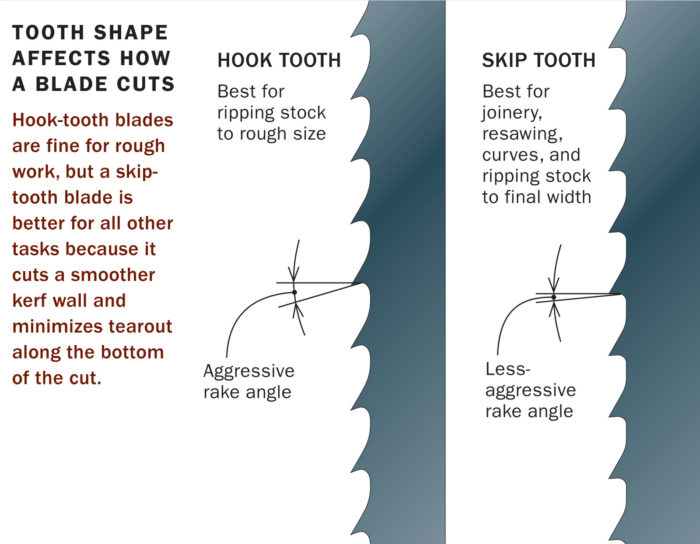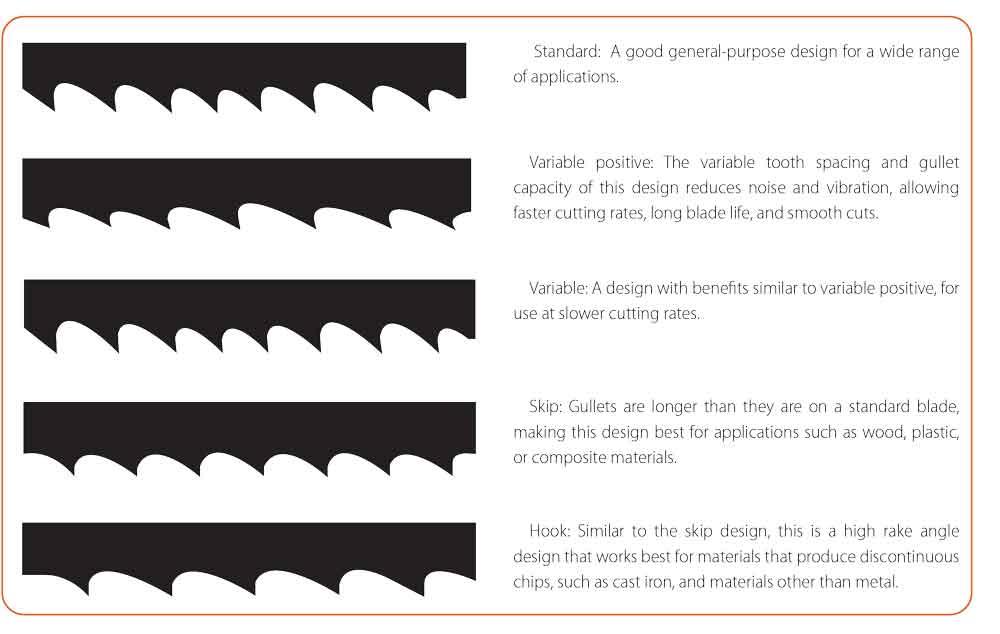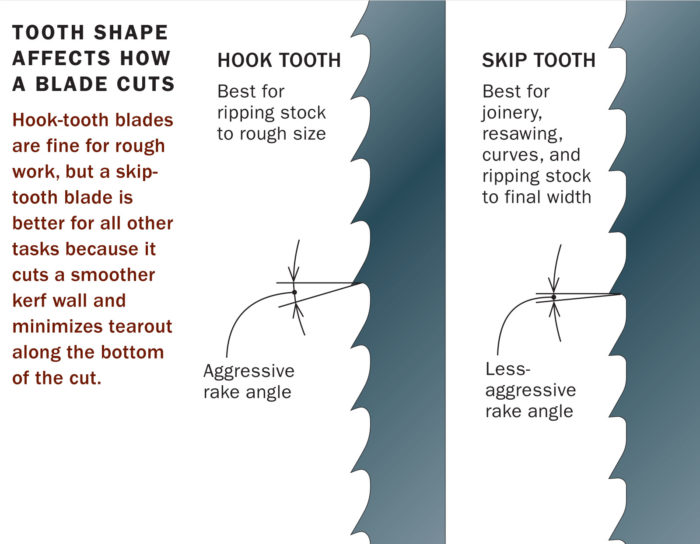Are you curious about what a skip tooth bandsaw blade is used for? Well, you’ve come to the right place! In this article, we’ll explore the world of bandsaw blades and discover why the skip tooth design is so special. So get ready to dive right in and learn something new!
Now, let’s imagine you’re working on a woodworking project or perhaps even a DIY masterpiece. You need to make precise and clean cuts in various materials like wood, plastic, or metal. That’s where the skip tooth bandsaw blade comes into play. It’s a type of blade that’s specifically designed to tackle these cutting tasks with efficiency and finesse.
But what’s so unique about the skip tooth bandsaw blade? Well, it features teeth with larger gaps in between, creating a skip-like pattern. This design allows for efficient chip removal, preventing clogging and heat build-up while cutting through thick materials. In other words, it makes your cutting experience smoother and more effortless.
So, whether you’re a seasoned woodworker or just starting your DIY journey, understanding what a skip tooth bandsaw blade is used for is essential. It’s the go-to choice when you want clean cuts in thick materials without compromising on speed and precision. Get ready to take your cutting game to the next level with the skip tooth bandsaw blade!

What Is a Skip Tooth Bandsaw Blade Used For?
A skip tooth bandsaw blade is a type of cutting tool used in bandsaws, specifically designed for making fast and rough cuts in materials like wood and soft plastics. The skip tooth configuration means that every other tooth on the blade is skipped or absent, creating extra space between the teeth. This unique design allows for efficient chip clearance and reduces the risk of clogging or overheating during the cutting process. In this article, we will explore the various applications and benefits of using a skip tooth bandsaw blade.
Benefits of Using a Skip Tooth Bandsaw Blade
When it comes to cutting through thick or dense materials, a skip tooth bandsaw blade offers several advantages. Firstly, the larger gullets, or the spaces between the teeth, allow for easy removal of sawdust and debris, preventing the blade from getting clogged. This helps maintain the blade’s sharpness and prolongs its lifespan. Secondly, the skip tooth configuration reduces the amount of friction during the cutting process, minimizing heat buildup and preventing the blade from warping or becoming dull. Lastly, as the skip tooth blade removes material more quickly, it results in faster cuts, making it an efficient choice for projects that require speed.
In addition to these benefits, a skip tooth bandsaw blade is also ideal for cutting softer materials, such as green or wet wood, where a smooth finish may not be a priority. The rougher cut provided by the skip tooth blade is perfect for tasks such as rough dimensioning or cutting through thick lumber. Whether you are a professional woodworker, DIY enthusiast, or hobbyist, a skip tooth bandsaw blade can be a valuable tool for your cutting needs.
Applications of Skip Tooth Bandsaw Blades in Woodworking
1. Rip Cutting: Skip tooth bandsaw blades are commonly used for rip cutting, which involves cutting a piece of wood along the grain. The skip tooth’s aggressive tooth configuration allows for quick and efficient removal of material, making it a preferred choice for this type of cut.
2. Resawing: Resawing refers to cutting a board into multiple thinner pieces, creating bookmatched veneers or creating thicker stock from thinner boards. Skip tooth bandsaw blades are well-suited for resawing due to their ability to handle thick materials and their efficient chip clearance.
3. Curved Cuts: The skip tooth bandsaw blade’s design makes it ideal for cutting curves in various materials. The gaps between teeth prevent the blade from binding or overheating, allowing for smooth and precise curved cuts.
Benefits of Skip Tooth Bandsaw Blades in Plastic Cutting
1. Fast Cutting: When working with soft plastics, speed is often a priority. The skip tooth configuration allows for faster cutting, allowing you to complete your plastic cutting projects more efficiently.
2. Chip Clearance: Soft plastics can produce a significant amount of debris and chips during cutting. The skip tooth bandsaw blade’s design provides efficient chip clearance, preventing clogging and ensuring clean cuts.
3. Reduced Heat Buildup: Overheating can be a concern when cutting plastics. The skip tooth design reduces friction and heat buildup, minimizing the risk of melting or warping the plastic material.
How to Extend the Lifespan of a Skip Tooth Bandsaw Blade
To get the most out of your skip tooth bandsaw blade and ensure its longevity, it’s essential to follow these tips:
1. Proper Blade Selection: Choose the appropriate skip tooth bandsaw blade for your specific application and the material you’ll be cutting. Blades come in different sizes and tooth configurations, so select the one that suits your needs best.
2. Adequate Tension: Maintain the proper tension on your bandsaw blade to ensure optimal performance. Refer to your bandsaw’s manual for the recommended tension specifications.
3. Lubrication: Apply a suitable lubricant to the blade to reduce friction and heat buildup during cutting. This helps prevent premature wear and tear.
4. Correct Cutting Speed: Use the appropriate cutting speed for the material being cut. Cutting too fast or too slow can strain the blade and lead to premature dulling or breakage.
5. Regular Maintenance: Keep the blade clean and free from debris. Inspect the blade regularly for any signs of damage or wear and replace it as necessary.
By following these tips and using the skip tooth bandsaw blade correctly, you can maximize its lifespan and enjoy efficient and precise cutting for a long time to come.
Choosing the Right Skip Tooth Bandsaw Blade
When selecting a skip tooth bandsaw blade, consider the following factors:
1. Material Type: Determine the type of material you will be cutting. Different blades are designed for specific materials such as wood, plastic, or metal.
2. Blade Width: Choose a blade width suitable for your bandsaw’s capacity and the work you’ll be doing. The wider the blade, the more stable it will be during the cutting process.
3. Tooth Configuration: Consider the tooth configuration based on the type of cut you will be making. The skip tooth configuration is ideal for fast, rough cuts, while other configurations may be better suited for different applications.
4. Blade Thickness: Select a blade thickness that matches the demands of your cutting tasks. Thicker blades are more durable and suitable for heavy-duty cutting, while thinner blades provide finer cuts.
5. Blade Length: Ensure that the blade length is compatible with your bandsaw’s specifications. Refer to your bandsaw’s manual or consult with an expert if you are unsure.
By taking these factors into account, you can choose the right skip tooth bandsaw blade for your specific needs and achieve optimal cutting results.
Key Takeaways: What is a Skip Tooth Bandsaw Blade Used For?
A skip tooth bandsaw blade is a type of blade with widely spaced teeth. It is commonly used for cutting through thick and softer materials.
- Provide efficient and fast cutting through thick materials like wood and plastic.
- Leave a rough finish on the cut edges due to widely spaced teeth.
- Minimize the chances of clogging with sawdust or debris during cutting.
- Less likely to overheat during prolonged use due to the gaps between the teeth.
- Not suitable for cutting metal or hard materials due to the rough finish.
Frequently Asked Questions
Welcome to our frequently asked questions section, where we address queries related to the uses of skip tooth bandsaw blades. These blades are a popular choice among woodworkers, offering unique advantages for specific applications. Read on to find answers to your questions.
Q1: How does a skip tooth bandsaw blade differ from a regular bandsaw blade?
A skip tooth bandsaw blade has a specialized tooth pattern with large gaps between the teeth. Unlike regular bandsaw blades that have closely spaced teeth, the skip tooth blade leaves wider gaps between each tooth. This design allows for efficient chip removal and prevents clogging, making it ideal for cutting through green wood or materials like foam or plastic.
The wider gaps also reduce the chances of heat buildup during cutting, prolonging the blade’s lifespan. The skip tooth blade’s unique tooth geometry reduces the strain on the blade, making it an excellent choice for cutting thicker materials or resawing lumber.
Q2: What are the primary uses of a skip tooth bandsaw blade?
Skip tooth bandsaw blades are commonly used for specific woodworking applications. One popular use is when cutting materials with low melting points, such as plastics or foam. The wide gaps between the teeth prevent heat buildup, reducing the risk of melting the material.
The skip tooth blade’s ability to efficiently remove chips makes it ideal for cutting green wood, as the large gaps prevent clogging. Woodworkers often use skip tooth blades when resawing thick stock or cutting lumber with natural curves, as the blade’s design allows for smooth and efficient cutting in these situations.
Q3: Can a skip tooth bandsaw blade be used for cutting metal?
Skip tooth bandsaw blades are not recommended for cutting metal. The large gaps between the teeth, which are advantageous for chip removal in woodworking applications, can cause excessive vibration and reduce cutting accuracy when used on metal. Additionally, the tooth geometry of skip tooth blades is optimized for cutting softer materials, making them less effective on metal surfaces.
For cutting metal, it is best to use a bandsaw blade specifically designed for that purpose. Metal-cutting bandsaw blades have a different tooth pattern and tooth geometry, allowing for cleaner and more precise cuts in metal materials.
Q4: Are skip tooth bandsaw blades suitable for intricate cuts and curves?
While skip tooth bandsaw blades excel at cutting thicker materials and resawing, they may not be the best choice for intricate cuts and tight curves. The wider gaps between the teeth can lead to less control and finer detail when navigating tight turns.
For intricate cuts and curves, a narrower blade with more teeth per inch (TPI) is generally preferred. These blades provide better maneuverability and allow for precise and intricate cutting operations, especially in thinner materials or when cutting intricate patterns.
Q5: How often should I replace a skip tooth bandsaw blade?
The lifespan of a skip tooth bandsaw blade depends on various factors, including the frequency of use and the materials being cut. In general, a well-maintained skip tooth blade can last for several months or even longer with regular usage. However, it is essential to monitor the blade’s performance and replace it when signs of dullness or deterioration become apparent.
Some common indicators that a skip tooth blade needs replacement include decreased cutting efficiency, increased vibration during operation, and difficulty in obtaining clean and precise cuts. Regular inspection and maintenance, such as cleaning and proper tensioning, can help extend the blade’s lifespan and ensure optimal performance.

Summary
A skip tooth bandsaw blade is a tool with widely spaced teeth used for heavy-duty cutting. It is ideal for slicing through thick materials like wood, metal, and plastic. The gaps between the teeth help prevent clogging, making it easier to remove debris. This type of blade offers faster cutting speeds, but it may result in a rougher finish. It is commonly used in woodworking, metalworking, and other applications that require aggressive cutting. Safety precautions should be taken when using this blade to avoid accidents or injuries.
